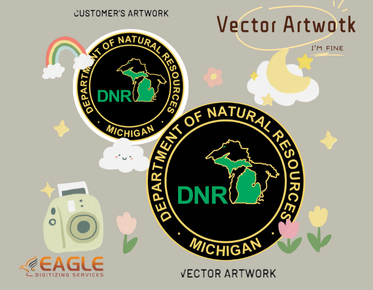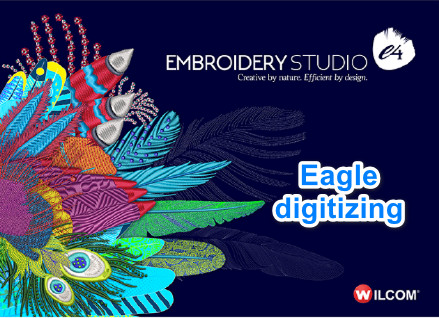Screen Printing 101: Advantages and Practical Benefits from Eagle Digitizing
Screen printing, a time-honored technique, remains a cornerstone in various industries. Its versatility and durability make it an enduring choice for businesses and creatives alike. This article delves into the significance of screen printing, exploring its benefits, advantages over other methods, and practical applications. For the top-notch online vector conversion, don't hesitate to get in touch with us.
The Essence of Screen Printing
A Brief History of Screen Printing
Screen printing has ancient roots, originating from the stenciling techniques used in China around AD 221. It spread to Japan and other Asian countries, evolving over centuries. In the early 20th century, it gained popularity in the West, particularly in the commercial and artistic sectors.
How Screen Printing Has Evolved
From hand-cut stencils to sophisticated digital processes, screen printing has continually adapted to technological advancements. Modern methods incorporate automated machinery and advanced inks, enhancing precision and efficiency while retaining the technique's core principles.
Why Screen Printing Still Matters Today
In an age of rapid digital advancements, screen printing maintains its relevance. Its ability to produce vibrant, durable prints on a wide range of materials ensures its continued importance. Screen printing is valued for its cost-effectiveness, especially for large orders, and its unique aesthetic qualities that digital methods often can't replicate.
Benefits of Screen Printing
Cost-Effective for Large Orders
Screen printing shines when it comes to large-scale production. The setup cost is offset by the low per-unit cost for high-volume orders, making it an economical choice for businesses needing bulk production.
High Durability and Longevity
Prints created through screen printing are highly durable, resisting fading and wear over time. This makes it ideal for products that require long-lasting designs, such as apparel and promotional materials.
Versatility Across Materials
Screen printing can be applied to a variety of substrates, including textiles, paper, glass, wood, and metal. This versatility allows for broad applications across different industries, from fashion to industrial manufacturing.
Advantages Over Other Printing Methods
Comparing Screen Printing to Digital Printing
While digital printing is excellent for short runs and detailed images, screen printing outperforms in terms of cost efficiency for larger quantities and durability of prints. The tactile quality and vibrancy of screen prints often surpass those of digital prints.
Screen Printing vs. Heat Transfer
Heat transfer methods are convenient but can lack the durability of screen printing. Screen printing embeds ink directly into the material, resulting in a longer-lasting design that withstands repeated washing and heavy use.
Unique Benefits of Screen Printing
Screen printing offers unique advantages such as the ability to print on dark fabrics with bright, opaque inks and the creation of special effects like metallic or glow-in-the-dark prints. The technique also allows for thicker ink deposits, enhancing the print's texture and durability.
Detailed Look at Screen Printing Advantages
Vibrant and Long-Lasting Colors
Screen printing uses thick layers of ink, producing rich, vibrant colors that remain bright and intact over time. This makes it a preferred method for designs requiring high-impact visuals.
Precision and Detail in Designs
With the right setup, screen printing can achieve a high level of detail and precision. Fine lines and intricate patterns are reproduced accurately, making it suitable for detailed graphic designs.
Customization Flexibility
Screen printing offers immense flexibility for customization. From changing ink colors to using various types of meshes and emulsions, the technique allows for creative experimentation and personalization.
Practical Applications in Fashion
Custom T-shirts and Apparel
Screen printing is a staple in the fashion industry, particularly for custom t-shirts and apparel. Its ability to produce bold, durable designs makes it ideal for personalized clothing lines.
Sportswear and Team Jerseys
Sportswear and team jerseys benefit from screen printing's durability and color vibrancy. Logos, numbers, and names printed using this method withstand the rigors of athletic activity and frequent laundering.
High Fashion and Designer Brands
Even high fashion and designer brands utilize screen printing for its unique aesthetic qualities. The technique's ability to produce complex patterns and textures adds value to limited edition and bespoke garments.
Screen Printing in Marketing and Advertising
Promotional Products
From tote bags to t-shirts, screen printing is widely used to create promotional products. The cost-effectiveness and high-quality results make it a go-to method for branding and marketing campaigns.
Custom Banners and Signs
Screen printing is ideal for producing custom banners and signs that require durability and weather resistance. Its ability to print on various materials ensures that promotional signage remains vibrant and intact over time.
Branded Merchandise
Companies often use screen printing for branded merchandise, such as mugs, hats, and backpacks. The method's versatility allows for consistent branding across a wide range of products.
Uses in Art and Design
Limited Edition Prints
Artists favor screen printing for creating limited edition prints. The method's ability to produce vibrant, high-quality reproductions makes it a valuable tool in the art world.
Posters and Fine Art Reproductions
Screen printing is commonly used for posters and fine art reproductions. Its precision and color fidelity ensure that each piece captures the original artwork's essence.
Creative Artistic Projects
Screen printing's flexibility allows artists to experiment with different techniques and materials, resulting in innovative and unique artistic projects.
Industrial and Commercial Applications
Printing on Packaging
Screen printing is extensively used in the packaging industry for printing on various materials, including cardboard, plastics, and metals. Its durability ensures that packaging designs remain intact during transportation and handling.
Electronics and Circuit Boards
In the electronics industry, screen printing is used to apply conductive inks and solder masks on circuit boards. The precision and reliability of the method are crucial for the functionality of electronic components.
Labels and Stickers
Screen printing is ideal for producing high-quality labels and stickers. Its ability to print on different materials and produce vibrant colors makes it a preferred choice for product labeling and branding.
Screen Printing for Small Businesses
Starting a Screen Printing Business
Screen printing offers an accessible entry point for entrepreneurs. With relatively low startup costs and high demand for custom prints, it's an attractive option for small business ventures.
Benefits for Local Entrepreneurs
Local entrepreneurs can benefit from screen printing by offering personalized services to their communities. From custom apparel to promotional items, the possibilities are vast.
Case Studies: Success Stories
Many small businesses have thrived by incorporating screen printing into their services. Success stories often highlight the method's role in providing unique, high-quality products that cater to niche markets.
Environmental Impact and Sustainability
Eco-Friendly Inks and Materials
The screen printing industry is increasingly adopting eco-friendly inks and materials. Water-based and soy-based inks offer sustainable alternatives to traditional plastisol inks, reducing environmental impact.
Reducing Waste in Screen Printing
Efforts to reduce waste in screen printing include recycling screens and reclaiming used materials. These practices help minimize the environmental footprint of screen printing operations.
Sustainable Practices in the Industry
Sustainable practices, such as using energy-efficient equipment and reducing chemical usage, are becoming standard in the screen printing industry. These initiatives contribute to a more environmentally responsible printing process.
Technological Advancements in Screen Printing
Modern Equipment and Tools
Advancements in screen printing equipment and tools have significantly improved efficiency and quality. Automated machines and precise exposure units are among the innovations enhancing the screen printing process.
Innovations in Ink and Substrates
New ink formulations and substrates continue to expand the possibilities of screen printing. These innovations allow for more diverse applications and improved print quality.
Automation in Screen Printing
Automation is revolutionizing screen printing, making the process faster and more consistent. Automated screen printers reduce manual labor and increase production capacity, benefiting businesses of all sizes.
Training and Skills Development
Learning the Basics of Screen Printing
Numerous resources are available for those interested in learning screen printing, from online tutorials to hands-on workshops. Understanding the basics is essential for achieving high-quality prints.
Advanced Techniques and Workshops
Advanced screen printing techniques and workshops offer opportunities to refine skills and explore new methods. These resources help professionals stay updated with industry trends and innovations.
Online Resources and Tutorials
The internet is a valuable resource for screen printers, offering tutorials, forums, and instructional videos. These tools provide guidance and support for both beginners and experienced printers.
Common Challenges in Screen Printing
Dealing with Ink Issues
Ink issues, such as clogging or improper curing, can be challenging. Understanding the properties of different inks and maintaining proper screen tension is key to overcoming these problems.
Achieving Consistent Quality
Consistency in screen printing requires meticulous attention to detail. Factors such as screen tension, ink viscosity, and curing times must be carefully managed to ensure uniform quality.
Managing Production Costs
Efficient production management is crucial for controlling costs. Strategies include optimizing material usage, maintaining equipment, and streamlining workflows.
Future Trends in Screen Printing
Emerging Technologies
Emerging technologies in screen printing promise to further enhance the process. Innovations such as digital hybrid printing and advanced automation are set to redefine industry standards.
Market Growth and Opportunities
The screen printing market continues to grow, with increasing demand for custom and high-quality prints. This growth presents new opportunities for businesses to expand their services and reach.
Predictions for the Industry
The future of screen printing looks promising, with continued advancements in technology and sustainable practices. The industry's adaptability ensures its ongoing relevance in a dynamic market.
Screen printing remains a vital and versatile method with numerous benefits and applications. Its durability, cost-effectiveness, and customization capabilities make it indispensable across various industries. Eagle Digitizing offers vector graphics conversion services.
As technology evolves and sustainability becomes a priority, screen printing continues to adapt and thrive. Its enduring significance is a testament to its value in both traditional and modern contexts, ensuring its place in the future of printing.



.png)